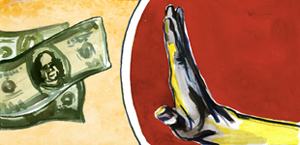Although tackling corruption is not an auditor’s function, audit processes can sometimes uncover irregularities better than the bodies tasked to do so.
Think of it as a car test. Audits are to institutions what a car test is to you and me. Picture yourself in the unavoidable and annoying queue many have to endure every year for their car to pass its official test. Although this process aims to check the minimum acceptable environmental and road safety standards required by law, it may also uncover a problem in the clutch or the gearbox, or even provide the annoying evidence that the clock of the car was vandalised by its cheeky previous owner to hide excessive mileage.
Just like a car test, society also has its way of flagging up its concerns and uncovering corruption in the process: an inflammatory headline unveiling and condemning the latest scandal can result in corruption allegations. Civil society protesting and demanding more transparency can also lead to the implementation of tougher anti-corruption measures.
Society too has a responsibility to do good “car tests”. They have their primary purpose – to check national safety, but they also have a vital additional function – identifying poor performance and corruption. Think about audits like those “car tests”: although tackling corruption is not a primary function or a legal responsibility of internal audits, many times they report corruption in a more thorough manner than anti-corruption bodies or authorities whose function it is to highlight and counteract corruption. And this becomes even more critical in the defence and security sectors where, under the veil of security, corruption is easier to conceal and harder to detect.
Our latest report “The 3rd line of defence: How audits help address defence corruption” illustrates precisely this point. Despite the bad reputation Ukraine might have on the corruption front, their Accounting Chamber, State Financial Inspection and Prosecutor General’s Office have all their audits available online.
Through the analysis of 200 Ukrainian audits and 200 Ukrainian law enforcement reports from the period between January 2010 and October 2011, this study shows how audits can expose the cost of corruption within a particular sector, by connecting the dots between an irregular or even corrupt procedure and the massive costs they can bring about.
The report exposes striking examples found in the public domain such as unfinished construction which cost £55 million and was not accounted for in the records of the Ukrainian Ministry of Defence; or internal affairs bodies receiving over £181 million for unverified services, as only 10 per cent of that money was used to simplify bureaucratic procedures, which resulted in Ukrainian citizens having to pay extra for access to basic services.
Corruption is unveiled in other examples as well, such as the case of a commander who hired an employee, yet allowed him to avoid coming to work to perform his duties for three years, despite paying for his wages; or officials using funds received from the sale of capital assets during alienation and write-off of specialised equipment, which resulted in damages to the state of up to £3.2 million. All these audit reports are like the car test, as in the monitoring process they are revealing other problems which would otherwise remain hidden.
Audits are teaching us a lesson here. They are flagging up corruption risks despite this not being part of their primary duties. Monitoring corruption shouldn’t be a task only for special units and agencies. It should be included in the daily responsibilities of each public servant, each serviceman, and each leader. Learning to build integrity and implementing internal anti-corruption procedures will see complacency gradually giving way to accountability. Everybody should contribute to building integrity, and educating and supporting an intolerant attitude towards all manifestations of corruption. Audits can and should support such efforts.
















 Connect with us on Facebook
Connect with us on Facebook Follow us on Twitter
Follow us on Twitter